Last week we celebrated the 10-year anniversary of our Women & Agriculture Conference and over 750 women joined us in Carlow. It is the one event in the year where you can be guaranteed honest feedback on how the Irish Farmers Journal is meeting the needs of our readers and what we can do to improve the coverage and services we provide. This type of feedback is invaluable to any business but unfortunately it is not always forthcoming.
The Women & Agriculture Conference is different from other meetings and conferences I attend throughout the year. I am not fully sure why, but believe that some people – and often women – are more comfortable at giving constructive feedback and respectfully challenging opinions.
There is of course the added dimension that perhaps men engage much better with this type of challenging feedback when it comes from women.
There are probably studies that explain why this is the case. But whatever the reason, it shows the role of gender-diverse management teams in preventing group-think and encouraging a culture of challenging engagement in the decision-making process.
There is no doubt that the benefits of having a gender-diverse management team is gaining increased recognition in the business world. And it is a trend that is becoming increasingly evident in our agri-food sector. However, farm organisations in particular have come in for much criticism for a lack of gender diversity at senior level.
It was no doubt extremely useful for IFA president Joe Healy and IFA director general Damian McDonald to be in attendance at our conference and hear the debate that took place. Clearly the presence of both men shows the importance they place on tackling the problem.
However, it would be too easy to simply lay 100% of the blame for the lack of female visibility within farm organisations and co-op boards at the doorstep of their respective presidents, chairs or senior executives.
One of the main reasons women are not visible at the top of these organisations is that, in many cases, they are not visible at county or branch level. This is where the conveyor belt starts and is perhaps where the problem originates.
There are some obvious reasons as to why this is the case, mainly the demands on both parties of juggling off-farm employment while at the same time rearing a family and maintaining a household. However, we have seen in the business world how these challenges can be overcome through innovation, mainly in the area of communication – to such an extent that management teams can now function despite operating remotely from the business hub.
In this sense, it is worth asking why county meetings and even national executives need to be confined to those sitting in the hotel function room or conference centre.
There are numerous platforms that could be used to allow members tap into these meetings and contribute remotely. Showing members what can be done with the right technology and what takes place might be a useful first step in encouraging wider participation within farm organisations – and not just of women. Perhaps this is one area the forum being established by the IFA to improve women’s visibility in the organisation could explore.
Meanwhile, it is no surprise that we have seen women’s groups being formed across the country. They are certainly a positive development but it will be important that they do not remain on the outside. Their contribution and impact on our sector will be greater if they can drive change and use their expertise to further strengthen farmer representation.
Ultimately, Irish agriculture will be worse off if we have to wait until next year’s Women & Agriculture Conference for women to have their voices heard again.
Women are an essential part of farming families and businesses across the country and we need them at the forefront on more than one day a year.






 This is a subscriber-only article
This is a subscriber-only article










SHARING OPTIONS: